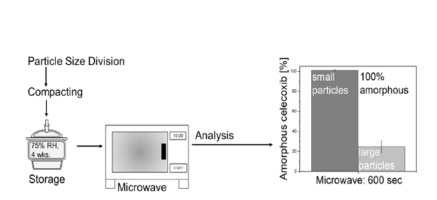当前位置:
X-MOL 学术
›
Eur. J. Pharm. Biopharm.
›
论文详情
Our official English website, www.x-mol.net, welcomes your
feedback! (Note: you will need to create a separate account there.)
The influence of drug and polymer particle size on the in situ amorphization using microwave irradiation.
European Journal of Pharmaceutics and Biopharmaceutics ( IF 4.4 ) Pub Date : 2020-02-05 , DOI: 10.1016/j.ejpb.2020.01.019 Nele-Johanna Hempel 1 , Matthias M Knopp 2 , Ragna Berthelsen 1 , J Axel Zeitler 3 , Korbinian Löbmann 1
European Journal of Pharmaceutics and Biopharmaceutics ( IF 4.4 ) Pub Date : 2020-02-05 , DOI: 10.1016/j.ejpb.2020.01.019 Nele-Johanna Hempel 1 , Matthias M Knopp 2 , Ragna Berthelsen 1 , J Axel Zeitler 3 , Korbinian Löbmann 1
Affiliation

|
In this study, the impact of drug and polymer particle size on the in situ amorphization using microwave irradiation at a frequency of 2.45 GHz were investigated. Using ball milling and sieve fractioning, the crystalline drug celecoxib (CCX) and the polymer polyvinylpyrrolidone (PVP) were divided into two particle size fractions, i.e. small (<71µm) and large (>71µm) particles. Subsequently, compacts containing a drug load of 30%(w/w) crystalline CCX in PVP were prepared and subjected to microwave radiation for an accumulated duration of 600sec in intervals of 60 sec as well as continuously for 600sec. It was found that the compacts containing small CCX particles displayed faster rates of amorphization and a higher degree of amorphization during microwave irradiation as compared to the compacts containing large CCX particles. For compacts with small CCX particles, interval exposure to microwave radiation resulted in a maximum degree of amorphization of 24%, whilst a fully amorphous solid dispersion (100%) was achieved after 600sec of continuous exposure to microwave radiation. By monitoring the temperature in the core of the compacts during exposure to microwave radiation using a fiber optic temperature probe, it was found that the total exposure time above the glass transition temperature (Tg) was shorter for the interval exposure method compared to continuous exposure to microwave radiation. Therefore, it is proposed that the in situ formation of an amorphous solid dispersion is governed by the dissolution of drug into the polymer, which most likely is accelerated above the Tg of the compacts. Hence, prolonging the exposure time above the Tg, and increasing the surface area of the drug by particle size reduction will increase the dissolution rate and thus, rate and degree of amorphization of CCX during exposure to microwave radiation.
中文翻译:

药物和聚合物粒度对使用微波辐照原位非晶化的影响。
在这项研究中,研究了药物和聚合物粒径对使用2.45 GHz微波辐射进行原位非晶化的影响。使用球磨和筛分,将结晶药物塞来昔布(CCX)和聚合物聚乙烯吡咯烷酮(PVP)分为两个粒径级分,即小(<71µm)和大(> 71µm)颗粒。随后,制备在PVP中包含30%(w / w)结晶CCX的药物载量的压块,并使其以60秒的间隔以及连续600秒的时间进行600秒的累积持续时间的微波辐射。已经发现,与包含大CCX颗粒的压块相比,包含小CCX颗粒的压块在微波辐射期间显示出更快的非晶化速率和更高的非晶化程度。对于具有小CCX颗粒的压坯,间歇性暴露于微波辐射会导致24%的最大非晶化程度,而连续暴露600秒后会获得完全无定形的固体分散体(100%)。通过使用光纤温度探头监测微波辐射过程中压坯的核心温度,发现与连续暴露于玻璃纤维相比,间隔暴露法在玻璃化转变温度(Tg)以上的总暴露时间较短。微波辐射。因此,提出无定形固体分散体的原位形成是由药物溶解到聚合物中来控制的,这很可能被加速到压实物的Tg以上。因此,延长曝光时间到Tg以上,
更新日期:2020-02-06
中文翻译:

药物和聚合物粒度对使用微波辐照原位非晶化的影响。
在这项研究中,研究了药物和聚合物粒径对使用2.45 GHz微波辐射进行原位非晶化的影响。使用球磨和筛分,将结晶药物塞来昔布(CCX)和聚合物聚乙烯吡咯烷酮(PVP)分为两个粒径级分,即小(<71µm)和大(> 71µm)颗粒。随后,制备在PVP中包含30%(w / w)结晶CCX的药物载量的压块,并使其以60秒的间隔以及连续600秒的时间进行600秒的累积持续时间的微波辐射。已经发现,与包含大CCX颗粒的压块相比,包含小CCX颗粒的压块在微波辐射期间显示出更快的非晶化速率和更高的非晶化程度。对于具有小CCX颗粒的压坯,间歇性暴露于微波辐射会导致24%的最大非晶化程度,而连续暴露600秒后会获得完全无定形的固体分散体(100%)。通过使用光纤温度探头监测微波辐射过程中压坯的核心温度,发现与连续暴露于玻璃纤维相比,间隔暴露法在玻璃化转变温度(Tg)以上的总暴露时间较短。微波辐射。因此,提出无定形固体分散体的原位形成是由药物溶解到聚合物中来控制的,这很可能被加速到压实物的Tg以上。因此,延长曝光时间到Tg以上,











































 京公网安备 11010802027423号
京公网安备 11010802027423号